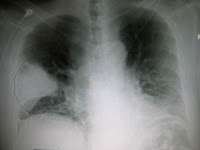This blog has moved to a new website
Nutrition, Health & Wellness
Home > Pneumonia - Signs and symptoms and causes of pneumonia in children and infants
According to WHO, pneumonia kills an estimated 1.2 million infants and children under the age of five years, accounting for 18% deaths among this age group. It is estimated that one in three newborn infant die due to this disease. Of these deaths 85% occur in South Asia and sub-Saharan Africa. Simple interventions and timely treatment, care and preventive measures can stop loss of life.
Causes of pneumonia in infants and children
Pneumonia is inflammation of the lungs. Often, it begins as an upper respiratory tract infection affecting nose and throat which subsequently affects lower respiratory tract (lungs). The microscopic air sacs (alveoli) in the lungs bring about gas exchange, resulting in exhalation of CO2 and absorption of oxygen. In lung inflammation/infection primarily alveoli get affected. The inflammation causes alveoli to accumulate fluids and the surface area for gas exchange gets reduced. This results in respiratory distress and connected symptoms.The lung inflammation and infection is usually caused by a variety of microorganisms, including bacteria, viruses, parasites or fungi. Bacterial lung infection in children and infants is usually caused by Streptococcus pneumoniae (or pneumococcus). Other common pneumonia causing bacteria are Haemophilus influenzae, Chlamydophila pneumoniae, and Mycoplasma pneumoniae, Staphylococcus aureus, Moraxella catarrhalis, Legionella pneumophila and Gram-negative bacilli. In infants and children affected by HIV, the incidence of this disease caused by Pneumocystis jiroveci is high and 25% of pneumonia deaths are due to P.jiroveci.
The viral lung infection in infants is commonly caused by Influenza virus A and B, Respiratory syncytial virus (RSV),Human parainfluenza viruses, rhinoviruses, human metapneumovirus and human bocavirus.
Fungal pneumonia in children is rarer and is mostly caused by Histoplasma capsulatum, blastomyces, Cryptococcus neoformans, Pneumocystis jiroveci, and Coccidioides immitis.
Parasites in human, which can affect the lungs, like Toxoplasma gondii, Strongyloides stercoralis, Ascaris lumbricoides, and Plasmodium malariae some times lead to fluid accumulation in lungs and pneumonia.
Pneumonia - Symptoms in infants and children
Viral and bacterial infections have similar symptoms and the viral infections are more numerous.The common symptoms of pneumonia in infants and children include:
- productive cough
- nasal congestion
- fever
- chills
- shortness of breath and difficult breathing
- rapid breathing
- increased respiratory rate
- loss and lack of appetite
- decreased activity and lethargy
- wheezing
- sharp or stabbing chest pain during deep breaths
- abdominal pain
- conjunctivitis due to chlamydia in infants
Symptoms of severity of pneumonia include:
- lower chest wall in-drawing during inhalation in children
- skin and nails becoming bluish,
- inability to feed or drink in infants
- decreased thirst
- convulsions
- nausea or persistent vomiting
- Extremes of body temperature (fever or hypothermia)
- decreased level of consciousness.
Malnutrition or undernourishment, compromised immune systems and pre-existing illnesses increase susceptibility of infants and children and can cause pneumonia. Environmental factors like air pollution, crowded homes and parental smoking also increase the risks.
Treatment of bacterial lung infection involves administration of antibiotics and patient care. Viral infection may resolve after some time as the patient develops immunity. For severe cases and young infants hospitalization is necessary. According to WHO, vaccinations against Haemophilus Influenzae Type b (Hib), pneumococcus, measles and whooping cough (pertussis) is the most effective way to prevent pneumonia in infants and children.
Related topics in Daily Health News & Tips:
Pneumonia in elderly - causes, symptoms, prognosis and treatment.
Pneumonia in elderly - causes, symptoms, prognosis and treatment.
Interesting topics in Daily Health News And Tips:
- tears in newborn.
- Tear ducts - Blocked tear ducts in newborn - Dacryostenosis.
- Social anxiety depression - Social anxiety disorder causes.
- Horseradish roots - Horseradish juice - Health Benefits.
- Severe hypothyroidism - side effects of hypothyroidism disorder.
- Chronic sinusitis treatment - balloon sinuplasty.
- Cloves (Syzygium aromaticum) - Health benefits of cloves.
- Prevent back pain in children from heavy backpacks.
- Celery juice nutrients - Health benefits.
1.http://www.who.int/mediacentre/factsheets/fs331/en/index.html
Images:
1.Image source:
http://en.wikipedia.org/wiki/File:PneumonisWedge09.JPG
Image author: James Heilman, MD
License: CC BY-SA 3.0
2.Image source:
http://en.wikipedia.org/wiki/File:Symptoms_of_pneumonia.svg
Image author: Mikael Häggström
License: Public domain
Current topic: Symptoms and causes of pneumonia in children and infants


No comments:
Post a Comment